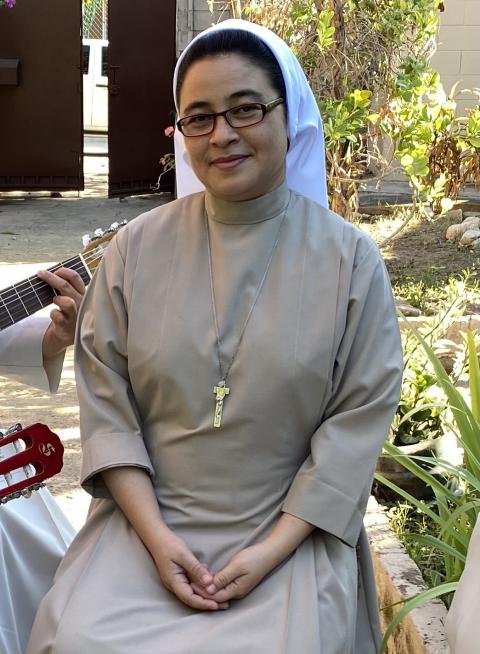
Notre Dame Sr. Sandra Margarita Sierra Flores poses for a photo in front of a mural of St. Oscar Romero on Jan. 27, 2024, in Chalatenango, El Salvador. She said she is inspired by the life of the saint, his writings and his devotion to the poor, which has influenced her ministry. (GSR photo/Rhina Guidos)
The slightly grainy video shows St. Oscar Romero with a trio of women religious, veils moving in the wind as they visit a family close to a row of homes made of tin and cardboard near railroad tracks. Captured by a Swiss film crew that visited Romero's El Salvador in 1979, it shows two groups of people never far from the daily life of the Salvadoran martyr: the poor and sisters.
"He's a novelty. When you're involved in the church, you don't see those in such places of power able to come down to reality," Notre Dame Sr. Sandra Margarita Sierra Flores told Global Sisters Report Jan. 27. "I say this with respect … but the reality is that when bishops ascend, the more they ascend, the further they get from the people."
But not Romero, she said. And that style — his words, actions and his closeness to sisters — has made Sierra part of a generation of younger women religious in Latin America who say the saint inspired their vocations and guides their ministries.
'(Oscar Romero) is a saint close to our time ,,, you identify with him and from that, make a clear option for the Gospel, for the poor, the marginalized.'
—Notre Dame Sr. Sandra Margarita Sierra Flores
"During my novitiate, that's when I drew closer to him," said Sr. Claudia del Rosario Zaldaña, a Carmelite of St. Joseph who serves in Heredia, Costa Rica. "What is surprising is his conviction to defend the dispossessed and vulnerable of his time. And that is always an invitation to take in the Gospel with radicalism."
That calling, Sierra said, drew him closer to the poor and the powerless, the place where one often finds sisters. Though originally from Honduras, Sierra studied at the Jesuit University of Central America in San Salvador, where she learned about Romero from the theological point of view.
She now serves in Chalatenango, a rural area in northern El Salvador, which was part of Romero's archdiocese during the civil war. Its "martyrial landscape," a place where more than 50 massacres are believed to have taken place, has taught her much about what he faced, she said.
Sierra said she has found much to inspire in the saint's writings and homilies, which give a name to victims and spell out abuses against them. He was a uniquely Latin American saint, but one who sets an example for the entire church in his "option for the poor, his great commitment," which should serve as motivation for all, she said.
"I like him because he is a saint close to our time and because of that reality, you identify with him and from that, make a clear option for the Gospel, for the poor, the marginalized," she said. "In the context of war, he was the voice of those without a voice, but for me, he is a model of the commitment of a Christian in times of conflict."
Sr. Zaira Gutierrez, right in yellow shirt, poses for a photo with other Apostolics of the Heart of Jesus, in front of art depicting St. Oscar Romero in San Salvador in November 2022. She said the life of St. Romero influenced her vocation and commitment to the poor. (Courtesy of Apostolics of the Heart of Jesus)
Romero was martyred March 24, 1980, in the company of Missionary Carmelites of St. Teresa after he pleaded with soldiers to stop killing civilians. Sisters ran to his side after he was fatally struck by a bullet during Mass in the chapel of a cancer hospital.
Even in death, sisters remained visibly close to the saint. Historic video prior to his funeral shows 11 sisters standing by his coffin, almost as if guarding it, as the thousands who mourned him tried to catch a last glimpse of their pastor at San Salvador's cathedral.
Though he didn't live to see the worst of the 12-year conflict that killed more than 75,000 civilians, violence against Salvadorans is part of Romero's diary. Sisters often appear in the diary in the most difficult of times.

Sr. Claudia del Rosario Zaldaña, a Carmelite of St. Joseph who serves in Heredia, Costa Rica, poses for a photo January 30, 2022, in Potonico, El Salvador. (GSR photo/Rhina Guidos)
His Sept. 11, 1979, entry documents a conversation with one of the Carmelites, urging him to find a different place to sleep that particular night, worried for his safety after a menacing phone call the sisters who lived near him received. In a Feb. 21, 1980, entry, Romero documents a visit with a sister in charge of a retreat house that suffered damage from a bomb placed at a radio station nearby that transmitted his homilies. Romero, who recorded his diary on cassettes, said Nov. 5, 1979, that a Salesian sister gave him a letter from the Vatican's secretary of state warning of credible assassination threats directed at him from the "far right."
"What he wrote in his diary captivated me. It's like looking at his essence as a person and how he accepted his calling and consecration," Zaldaña said.
While priests around the country were being killed, Romero also knew sisters, too, were risking their lives. Yet even in that danger, he drew closer to them.
Advertisement
The book Romereando por Chalate, about Romero's "pilgrimage through Chalatenango" in northern El Salvador, talks about his visits and closeness with Oblate Sisters of the Heart of Jesus, whom he visited after they had "an explosive device" placed at their residence in 1979. He always made it a point to drop by when the superior general was visiting, talking about the sisters' "protagonism" in the community, the book says.
That life of closeness, even while facing danger hasn't gone unnoticed by sisters today who have read about it.
"For me, there was a lot of influence [from the life of Romero], in my decision toward consecration," Sr. Zaira Gutierrez, of the Apostolics of the Heart of Jesus, told GSR March 4.
Arriving to serve in El Salvador from her native Mexico in 2012 was a time of "immense joy," she said, because it presented the opportunity to grow closer to the saint, often called "Monseñor" in his native land. But along the way, she learned about all the other Catholics in El Salvador who preceded and followed Romero in martyrdom, including two Maryknoll sisters and an Ursuline from the U.S., who along with a laywoman were raped and murdered Dec. 2, 1980.
"Monseñor, the martyrs and the Salvadoran people made me think about my vocation and my commitment," Gutierrez said.
La Chacra, where Gutierrez now lives on the outskirts of the capital of San Salvador, is where Swiss TV filmed Romero with the sisters while visiting the poor. Following El Salvador's civil conflict, the area became controlled by gangs, and Gutierrez' community has served there since 1990 inside a house that has a large mural of the saint facing the street.
Learning about Romero, how he offered his life, how he chose to follow Jesus in actions and words, made an impact on Gutierrez, who said Romero taught her how, in her life as a woman religious, she could "grow close to people, learn to be with them in their struggles, in their hopes, in their sorrows and shared feelings of joys, always knowing that we don't walk alone."
[This story was originally published in Spanish on March 18, 2024.]







